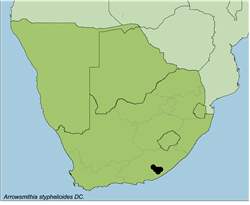Names and synonyms
Arrowsmithia styphelioides DC.= Macowania styphelioides (DC.) Kroner
Type
Drege 3762, Katberg, 1832-11-13 (P, HBG)
Derivation of names
Arrowsmitia = named in honour of an English geographer (mapmaker), John Arrowsmith (1780-1873). Of relevance here is the maps he made of Africa (1844) and of South Africa showing the routes of Dr. Livingstone between 1849 and 1857. He was known for his elaborate and carefully executed maps and was one of the founding members of the Royal Geographical Society.stypheloides = resembling members of Styphelia (Epacridaceae, a family of Australian heaths), which has rigid sharply pointed leaves.
Diagnostic characters
Stiff, lanceolate, spine-tipped leaves, bright green above and white-hairy below.Stems very densely leafyFlower heads solitary or 3-5 togetherFlorets yellow
Description
A compact shrub up to 0.3-0.5 m tall, with mutliple branches from the base. Stems rigid, bare in lower parts, very densely leafy on new branches, with a spiky appearance. Leaves 6-14 x 2-5 mm, alternate, sessile, erect, spreading or reflexed, lanceolate to ovate, bright green above, white-felted below; mucronate, margin entire and somewhat revolute, prominently 3-5-veined above; the base slightly clasping the stem. Capitula solitary or in groups of 3-5, heterogamous, radiate. Involucre funnel-shaped, 11-15 x 12-16 mm. Involucral bracts cartilaginous, in several rows; stereome undivided; ouside lower half woolly-hairy. Receptacle flat, epaleate. Female florets yellow, in one row, fewer than disc florets; cypselas with 20 ribs. Disc florets functionally male; corolla yellow, basally with long hairs as well as glandular hairs; corolla lobes erect; veins reaching the apex of the lobes; anthers ecalcarate, with short tails; endothecial tissue polarized; apical appendage acute, flat, as wide as thecae; cypselas with 5 vascular bundles, glabrous or with scattered, elongated, twin hairs, glandular -hairy. Pappus in ray and disk florets, bristles in one row; bristles barbellate, few, free, readily caducous; apical cells acute.
Flowering time
August to January.
Distribution
Restricted to a small area in the Eastern Cape.Known from about 20 collections in and around the Amatole Mountains (Katberg, Hogsback, Elandsberg) and as far West as Adelaide.
Habitat
Rocky or stony hillslopes in grassland or closed shrubland.
Notes
Arrowsmithia is very closely related to Macowania and has been included in Macowania by some researchers in the past. The correct status still needs to be established.
References
ANDERBERG, A.A. 1991. Taxonomy and phylogeny of the tribe Gnaphalieae (Asteraceae). Opera Botanica 104: 50-53.BERGH, N. 2011. Arrowsmithia styphelioides DC. http://ww.plantzafrica.com/plantab/arrowsmithstyp.htm.GLEN, H.F. 2004. SAPPI, What's in a Name? The Meanings of the Botanical Names of Trees. Jacana.HILLIARD, O.M. & BURTT, B.L. 1985. Notes on some plants of southern Africa chiefly from Natal: XI. Notes from the Royal Botanic Garden Edinburgh 42: 277-260.
